Take five teams of construction professionals, stick them in a roomful of Lego, get them to carry out three slightly offbeat tasks, and award them bonus points for good ideas on where to stick Santa⊠yes, folks, it can only be șĂÉ«ÏÈÉúTVâs 2014 Christmas challenge
![]()
Last Monday afternoon, with the final rays of pale winter sun weakening through the windows of șĂÉ«ÏÈÉúTVâs Southwark office, I receive a bemused call from the receptionist on the ground floor. âI have about 30 people here waiting to see you. They want to know what theyâre supposed to be doing.â
They may well ask. I go down to greet them, and they look no less mystified than our receptionist. To speak the truth, as I shepherd this confused collection of construction professionals senior and junior to our ninth floor boardroom, Iâm beginning to wonder what on earth Iâm doing myself.
Because this group is here for șĂÉ«ÏÈÉúTVâs 2014 Christmas challenge - set up to raise money for the magazineâs favoured charity, CRASH, and with the added benefit of delivering a crate of toys to a childrenâs charity in south London. The challenge itself? The five teams, who in a sense represent the breadth of the UK construction industry, are here to outdo each other in their skill, dexterity and imagination at the noble art of, er, Lego.

We reach the boardroom, grab a few drinks and I run through the tasks in hand with the teams. With me I have architects, engineers, surveyors, contractors and specialists from some of the UKâs top firms. You have two sets of Lego, I tell them, three tasks to complete and just 30 minutes per task. You also have some mince pies and a Lego Santa Claus - more of which later. Itâs not an announcement I ever thought Iâd be making, let alone to a room of top industry professionals.
Itâs a bit of fun, of course, but behind the nervous bonhomie there is already, before we start, some competitive edge. Teams stick to their little groups, surreptitiously sizing each other up. The group from demolition specialist Keltbray take off their coats, revealing that theyâre wearing branded t-shirts, and you can feel an additional frisson run round the room. This lot clearly mean business.
Their four rivals, eyeing them across the boardroom table, are contractor Paragon, architect HLM, quantity surveyor DBK, and a joint structural engineering team from URS and Aecom.
This somewhat bizarre event is inspired by a threefold combination of șĂÉ«ÏÈÉúTVâs desire to harness a bit of festive cheer for a good cause; 2014 being the year of The Lego Movie; and the fact that surely Lego is the iconic childhood toy for every budding construction professional. Who in the industry can honestly say they didnât spend hours with these little building blocks in their younger days? So a competition, we thought, pitting industry teams and disciplines against each other, would be the perfect way to raise a bit of money for CRASH.
Serious about Lego
We quickly realised weâd need someone external to help judge and - dare I say it? - add a bit of credibility to the process. Who better than one of the most well-known and respected construction clients in the land? Step forward, Flan McNamara, project director for Sellar Properties, developer of Europeâs tallest building, the Shard, who kindly agreed to give up his time to take part.
Coming up with the idea, it felt a dead cert Legoâs marketing department would see the benefits of providing some free Lego to aid our event, thereby generating a little bit of good publicity through helping impart a bit of Christmas cheer to the homeless and under-privileged.
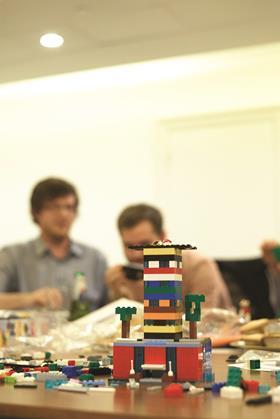
But alas, it proved not to be the case, as Legoâs UK head of press somewhat impatiently explained to me. âOur target market is nine year old boys,â she intoned tersely. âDoes your publication reach many of those? Email me a formal proposal.â Needless to say my pleading email was never answered.
Still, despite the set-back, the idea was too good to drop. And in fact, inadvertently the Scrooges at Lego gave us another idea: surely, then, we should involve the toyâs key demographic in the judging process? Cue the involvement of Oscar, the nine year-old son of regular șĂÉ«ÏÈÉúTV writer David Blackman. So now we had our judging team: Flan McNamara, alongside editor Sarah Richardson, and Oscar - without a casting vote, but given free rein to be brutally frank in his assessment of the teamsâ creations.
The challenge
A call was put out and within a couple of days we had five firms willing to put teams forward. But what to ask them to do? As well as being the year of The Lego Movie, 2014 has also been the year things began to look a little brighter for much of the construction sector. So we asked our contestants to âbuild the recoveryâ out of Lego in three discrete tasks: first, to build a replica of Richard Rogersâ Leadenhall building, aka the Cheesegrater, which was completed this year and constructed through the recession; second, to design their own project which somehow represented the recovery; and third, to complete a final mystery task. The tasks were emailed in advance, along with a place, time and date - and here we were.
So briefing the teams against the backdrop of the darkening London skyline, I tell them each building will be ranked out of 10 in three categories: design and concept; structural integrity (whether it is likely to fall over); and delivery (whether the project is finished in the time allotted). Oh, and for good measure, a final curve ball. We will give a bonus three points each round to the most creative positioning of our Lego Santa within the development. So, time for a final gulp of wine, and off we go.
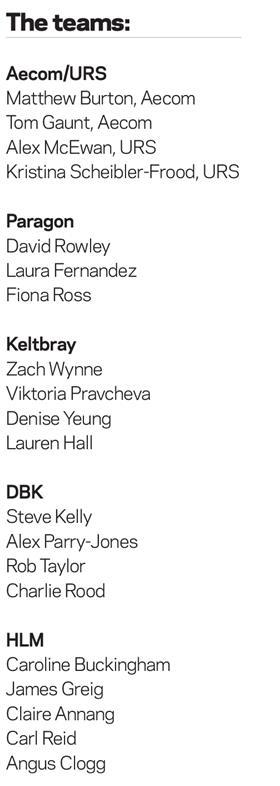
The mini Cheesegrater
As I start the timer, itâs immediately clear how seriously people are taking this: four out of the five teams pull out pre-prepared print-outs of architectural elevations of the Cheesegrater, with all having detailed photos. There is a palpable and intense buzz of activity. I attempt to wander round and quiz the teams on their approach, but they donât want to talk: theyâre not going to get the Cheesegrater built in half an hour if they mess about chatting.
However, 15 minutes in and itâs clear some - nay, most - of the teams are struggling. It is also clear that expecting people to actually build the Cheesegrater in 30 minutes is little short of a Herculean labour. There is very little evidence of anything looking much like a Cheesegrater - or any other kitchen implement for that matter. Aecom/URS and Keltbray look furthest ahead - demonstrating different approaches to getting good performance from a team. Aecom/URS, with âtoo much time on our handsâ the previous Friday had prepared and allotted different roles to different team members. And Keltbray? âWe were told weâd lose our jobs if we didnât do well,â one of the team jokes. At least Iâm hoping heâs joking.
DBK is one of the teams that doesnât seem to have got very far. âItâs all in the planning,â they tell me, about five minutes from the end. HLM suffer a âcatastrophic failureâ - I think that means a bit falls off - just 30 seconds before the end, and then all too quickly thatâs it: timeâs up.
The teams look a little shell-shocked. âItâs basically done but we had last minute glitches,â Paragonâs team tells me: âClient changes,â they explain. The judges arenât so sure, as they go round discussing the teamsâ efforts, and prodding the towers to see if anything falls off. QS DBK, who made a heroic effort in the last few minutes, do admit to having carried out âa little bit of value engineeringâ on the facade, which, on close inspection, doesnât appear to be attached to the rest of the building. The judges are less than impressed at James Greig from HLMâs explanation for his firmâs wobbly lift shaft. âWe were attempting to insert some tension into an otherwise rigid structure,â he blusters under questioning.
Thereâs no doubting though, that overall these efforts are valiant in the short time given. Itâs closely fought, but Keltbray are victorious in the first round. âIâm really impressed,â says judge Flan. âThis is not easy at all, and however much theyâre chatting and joking, thereâs no doubt these people feel under pressure - theyâre in the spotlight and they want to win.â
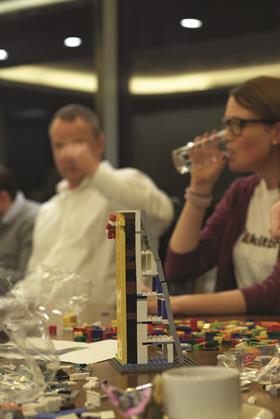
Recovery mode
However, no sooner do the teams partially dismantle their Cheesegraters, and draw breath, than itâs on to the next task: building the recovery.
Here pre-planning is again vital, and itâs quickly evident some teams have thought harder in advance than others. Concept is everything. The Aecom/URS team has a printed out aerial shot of the Battersea masterplan, and theyâre busy concocting on top of it a replica of the building which, for them, represents the recovery. âComplete with inappropriately dense flats surrounding it?â I suggest. âOh yes,â pipes up one member of the team, holding a structure he is manufacturing entirely from glass bricks to fill the brief.
Other teams are going for a more metaphorical approach: Paragon, building a somewhat uninspiring squat structure, offers reassurance. âThere is a thought process,â says Fiona Ross. âIt represents the solid foundations we need for the recovery.â On top of this, she explains, will be different structures representing risk, transparency, âgoing into the blackâ and âgreen shootsâ. All topped by Santa surfing the wave of growth. Thereâs impressive thought gone in at least.
Keltbray is also taking the metaphorical approach with a structurally audacious building created over a largely empty space containing some broken foundations. âșĂÉ«ÏÈÉúTV on the remnants of the past,â is the explanation, but it looks dangerously top-heavy to me. Zach from the team rejects the suggestion: âWeâve tested the tortional capacity. Itâll hold,â he says, giving it a push himself for good measure.
As the time ticks on, itâs clear the team from HLM has stolen this round. Also taking Battersea Power Station as their inspiration, theirs is a more creative approach. Each team member is tasked with designing their own tower and the result is a complete re-imagination of the building. When the time is up, the ever eloquent Greig waxes lyrical about the ânegative spaces framing the public realmâ in the scheme, and itâs clear the firm can talk the talk to back up their design. HLM is the round winner.
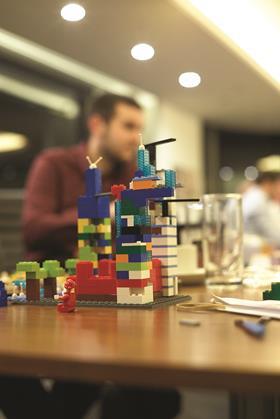
The mystery round
Now itâs time for the mystery task. Itâs here I reveal the relevance of the fact that one of the packs of Lego for each team is a set of âarchitecturalâ Lego containing the pieces to build no less than a replica of the world-famous UN headquarters building in New York. Designed by the 20th centuryâs two titans of modernist architecture, Le Corbusier and Oscar Niemeyer, it is an icon of the international style - how hard can it be to build a Lego replica given they already have the right pieces? The challenge is simply that Iâve taken away both the instructions and the box showing what the complete model looks like.
A groan goes through the room as they realise what they have to do. After a couple of minutesâ preparation time, where I fetch some pictures of the actual building to help them, theyâre off on the third and final challenge. Once again, the activity is intense. I overhear a debate raging in the Keltbray team at one point: âItâs not a clichĂ©d approach, itâs traditional.â Itâs not a discussion I necessarily expect to hear coming from within a demolition specialist, but it shows passions are running high.
The teams quickly demonstrate their ingenuity by downloading the instructions from the web with their iPhones - I have to intervene and ban their use. But, nevertheless, theyâre getting into their stride, all the teams having by now worked out how to effectively divide labour, and work progresses quickly. Aecom/URS take an innovative approach which attempts to mimic the curved facade of the low rise building that sits alongside the central high-rise block, but most teams concentrate their firepower on the iconic main tower.
Time is almost up and the breadth of interpretation of the brief is amazing to see, with the New York complex never having looked so different. Itâs fair to say Niemeyer and Corbusierâs elegant and slim-line modernist structure looks a little more dumpy in some of the teamsâ versions. Once again Keltbray have done the best job, faithfully representing the whole of the site. So despite Santa bonuses being awarded to other teams in each of the rounds, itâs not enough to prevent the branded-T-shirt-wearing demolition specialists being named the overall winner.
As we present them with a bottle of champagne, Flan sums it all up: âIâve been gobsmacked how good all of the efforts have been. Every one of you got the tasks done in the time, and you should all be very proud of your teamwork, and your output - especially with a few festive refreshments inside you.â And Oscarâs view? âItâs funny, grown-ups playing with Lego. Itâs like a building site, but cool.â And with that the challenge is over.
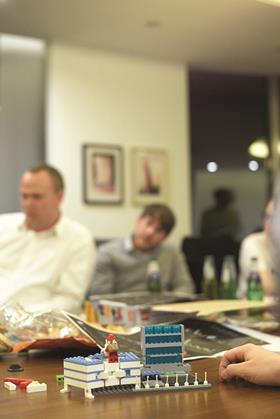
Round 1
The challenge: To build the Cheesegrater
Winner: Keltbray
Judgesâ comments: Keltbrayâs effort really captured the spirit of the building. It was delivered on time and with minimal fuss
Oscarâs view: âI donât think the winner was the best. I like the different colours and steps [of Paragonâs Cheesegrater]. Itâs quite cool: looks a bit like a helipad. What is the Cheesegrater? Iâm just going to think of it as the Shard.â
Santa bonus: HLM won the Santa bonus for their positioning of Father Christmas looking somewhat wobbly on the ground at the foot of the building. Whatâs happened to him? âHeâs been hit by a falling bolt,â the team explained.
Round 2
The challenge: To âbuild the recoveryâ out of Lego
Winner: HLM
Judgesâ comments: HLMâs imaginative re-working of Battersea Power Station showed real creativity and design flair as well as demonstrating how to blend individual creativity with intelligent team working, with each architect designing their own chimney stack.
Oscarâs view: âI prefer this one [HLM]. Thatâs cool, I like it.â
Santa bonus: Paragon won for a Santa who was surfing the wave of the recovery at the top of his building.
Round 3
The challenge: To build the iconic UN Headquarters building using the correct pieces - and no instructions
Winner: Keltbray
Judges comments: Keltbrayâs final building was by far the closest to the original. They worked together as a team, with each contributing individual elements to the whole, and the final building, delivered in good time, was a faithful representation of the iconic 1952 structure.
Oscarâs view: [URS/Aecomâs] is like a kung fu place, where they keep the weapons and the ninjas go there to practice. I like that one best more than the winner.
Santa bonus: URS/Aecom won the santa bonus by putting him on the roof of the low-rise block adjacent to the principal tower, where he appeared to be fiddling with a small disk. What was he up to? âHeâs trying to sort the dodgy phone reception,â the engineers explained.
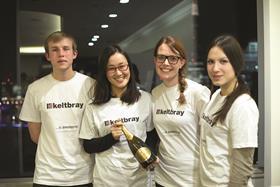
Overall winner: Keltbray
In their own words - how we won it by the Keltbray team
Denise Yeung, graduate engineer, Keltbray Piling (pictured, second left): âWe only got to know everyone in the team two hours before the competition. We discussed for 10-15 minutes how to deliver the Cheesegrater building and decided to go for a âtop downâ approach. The planning beforehand helped us to get a brief idea so we didnât have to waste time on planning within the given timeframe. The smooth delivery for the first task was a good warm-up exercise for us and after that we were more used to our division of work and the dynamics of the team. We split the tasks between the four of us and checked on each otherâs progress from time to time so we could help each other if necessary. During the competition, one of us was also in charge of time-keeping so we were all aware of how much time was left.
âWe were very pleased and amazed by how well the team worked despite the fact that the four of us had never worked together before. It was the planning beforehand and communication within the team that helped us.â
Zach Wynne, student engineer, Wentworth House Partnership, part of Keltbray (pictured, far left): âOur preparation was a vague discussion about Lego in general on the train to the competition and the threat of eternal disgrace if we failed hanging over our heads like a winter snowstorm.
âIn the end it was all about the team T-shirts. Thatâs all there was to it. Look the part, be the part. Apart from that, our divide and conquer approach, splitting up each model into a handful of sections and working individually or in pairs before bringing it all together at the end, really allowed us to maximise our output in the time available.â




























No comments yet